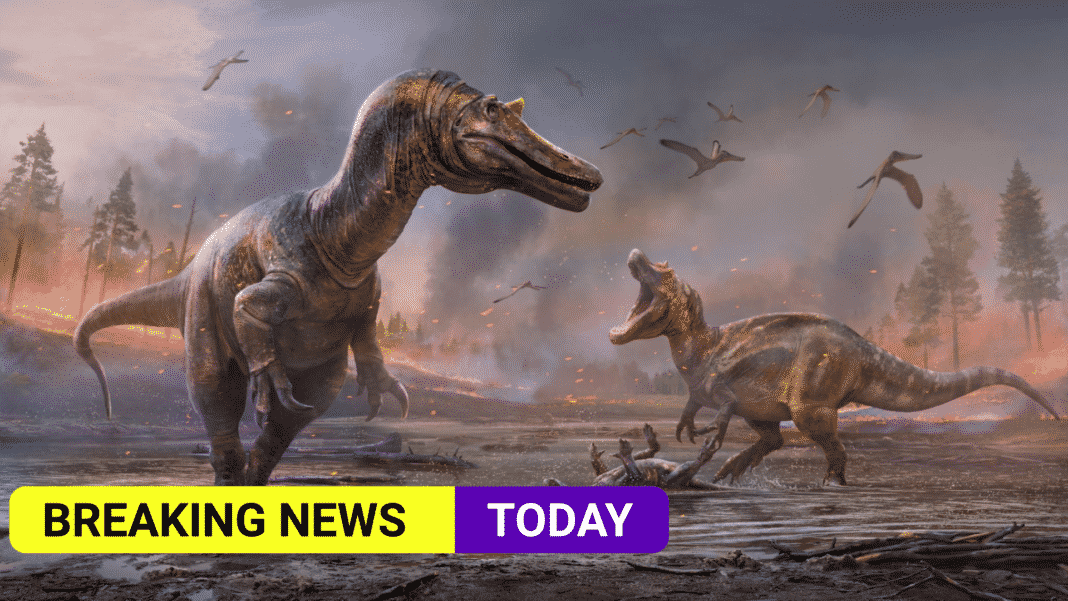According to scientists, bones discovered on the Isle of Wight belong to two previously undiscovered species of large predatory dinosaur
Scientists have named one of the dinosaur species the “horned crocodile-faced hell heron”, while the other is called “Milner’s riverbank hunter” in honour of the late palaeontologist Angela Milner.
According to scientists, bones discovered on the Isle of Wight belong to two previously undiscovered species of large predatory dinosaur.
The bones had been laid down over 125 million years ago during the Early Cretaceous period, before they had been unearthed on the beach near to Brighstone over the past few years by both fossil collectors and academics.
The dinosaurs that the bones belonged to had been closely related to the giant Spinosaurus and had unusual crocodile-like skulls that had allowed them to hunt their prey both on land and in the water.
Previously, the only spinosaurid skeleton to be found in the UK belonged to the dinosaur known as Baryonyx, which had been found in a quarry in Surrey in 1983. The majority of other finds were limited to isolated teeth and single bones.
This comes after the business secretary has said that soldiers will be delivering fuel in the next couple of days to ease petrol supply issues. Kwasi Kwarteng, the UK’s business secretary, has admitted that the past few days, which have seen long queues outside petrol stations and some pumps running dry, had been “difficult”.
Researchers from the University of Southampton had analysed the find and have confirmed that they had belonged to previously unknown species of dinosaurs, within a study that was published within the journal Scientific Reports.
Chris Barker, who is a PhD student from the University of Southampton, as well as the study’s lead author, said: “We found the skulls to differ not only from Baryonyx, but also one another, suggesting the UK housed a greater diversity of spinosaurids than previously thought.
Co-author Darren Naish has said that he’d been waiting for a Baronyx-like discovery located on the Isle of Wight for a couple of decades, but that finding the two species in close succession was a “huge surprise”.

The first of these dinosaurs has been named Ceratosuchops inferodios, which translates as the “horned crocodile-faced hell heron”.
This dinosaur has a series of low horns, as well as bumps ornamenting its brow region, and “hell heron” which refers to its likely hunting style, as herons catch their aquatic prey around the margins of waterways but can also eat their terrestrial prey.
The second was given the name Riparovenator milnerae, which translates as “Milner’s riverbank hunter”, in honour of the renowned British palaeontologist Angela Milner who had passed away this August and had named Baryonyx.
Another co-author from Queen Mary University of London, Dr David Hone said: “It might sound odd to have two similar and closely related carnivores in an ecosystem, but this is actually very common for both dinosaurs and numerous living ecosystems.”
This comes after thousands of people, including key NHS staff and teachers have said that they are unable to get to work due as a result of the national fuel shortage crisis, with some facing the prospect of potentially returning to working from home where possible.
Dr Neil Gostling of the University of Southampton, who supervised the project, said: “This work has brought together universities, Dinosaur Isle museum and the public to reveal these amazing dinosaurs and the incredibly diverse ecology of the south coast of England 125 million years ago.”
Dr Martin Munt, who is the curator of the Dinosaur Isle Museum where the new finds will be going on display, said that they cemented the Isle of Wight’s status as being one of the top locations for dinosaur remains within Europe and highlighted how both collectors and academics, as well as museums would be working together on new finds.
Dr Munt added: “On behalf of the museum I wish to express our gratitude to the collectors, including colleagues at the museum, who have made these amazing finds, and made them available for scientific research. We also congratulate the team who have worked on these exciting finds and brought them to publication.”
